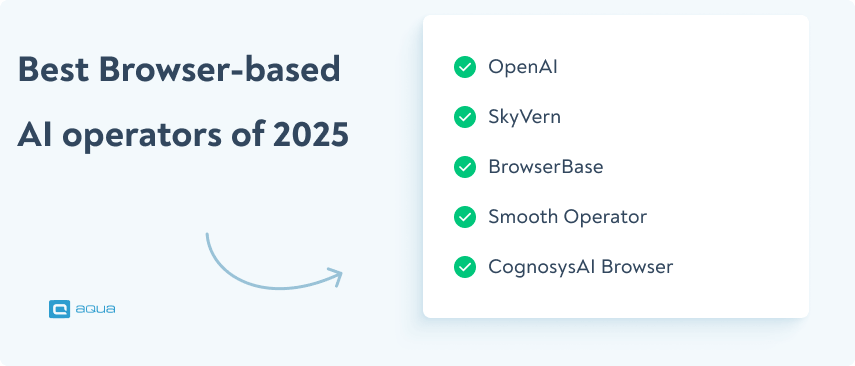Key Takeaways
- Browser-based AI operators use machine learning and computer vision to interact with web applications like human testers without relying on brittle selectors or scripts.
- AI operators can adapt to UI changes and self-heal when elements move or change, drastically reducing test maintenance compared to traditional automation.
- Manual QA testers can now automate tests without coding skills, while automation engineers need to pivot toward prompt engineering and strategic oversight.
- Current AI operators have limitations including high costs (around 10 cents per screen analysis), less predictable behavior, and still-evolving capabilities for handling complex UI interactions.
- Popular browser-based AI operators include OpenAI Operator, Skyvern, Browserbase, Smooth Operator, and CognosysAI Browser, each with different capabilities and integration options.
AI-powered test automation promises to democratize QA, but it comes with real trade-offs in control and cost. Ready to see if these self-healing tests could transform your testing approach? Explore the details below 👇
Apart from automating tests, they think, adapt, and even heal themselves when things go wrong. But before you start seeing a utopia where bots do all the work, let’s get real and cover these operators from both positive and negative aspects.
What is an AI Operator? (And Why Should You Care?)
You can imagine an AI operator inside your computer like a QA engineer. Using machine learning and computer vision, it interacts with web applications just like you would.
Need to test a login flow? Instead of writing 50 lines of Selenium code, you tell the AI:
“Log in as a user with invalid credentials and see what happens.”
Then the operator goes and:
- Navigates the UI
- Clicks buttons,
- Fills forms
- Even interprets error messages.
But it doesn’t rely on XPaths or CSS selectors. It sees the screen like a human, which means it can handle UI changes effortlessly. Imagine your dev team pushes a last-minute button redesign. Instead of your automation suite failing, the AI just… figures it out.
"After experimenting with LLMs, we discovered they can be really good at browsing and using websites like real users. In our previous jobs we've never had a proper end-to-end testing automation and mainly relied on manual testing and users feedback."
The Future of Web Test Automation: Manual QA Win, Automation QA Adapt
Let’s start visioning where we are now with test automation:
- Nearly 50% of companies use AI for test automation. Most use it for creating test cases, generating test data, and detecting defects.
- More than 24% of companies have automated 50% or more of their test cases.
- 53% of companies use automation for regression testing.
We need to get one thing straight: AI operators aren’t here to replace humans (not yet). They’re here to make humans more powerful. According to a study, by the end of 2025, AI copilot functionality will be used in nearly 100% of roles across the SDLC. Bold prediction, but not far from reality. If not 2025, it will be a maximum of 2-3 years before it happens.
For QA, this means manual testers can now automate tests without writing a single line of code.
But for automation engineers, the story is different. If your job is writing Selenium scripts, you need to start upskilling. AI operators don’t need scripts—they need prompts. Instead of coding, you’ll be:
- Guiding the AI
- Setting boundaries
- Interpreting results
So it’s less about technical expertise and more about strategic thinking (in this case, prompt engineering). If you love the technical aspect of your job more than the strategic part, then you need to lock in, find the gaps and inconsistencies in these operators so you can stay ahead, and adapt continuously till you make your strategic skills as good as the technical ones.
The Pros and Cons of AI Operators (With Real-World Scenarios)
Now it’s time to look at the two sides of the coin. Are these operators life-saver, or just another hype in the age of AI?
Pros
1. Low Tech Barrier: You’re a manual QA with zero coding experience. Your team needs to test a new e-commerce checkout flow. Instead of waiting weeks for an automation engineer, you use an AI operator. You type: “Add a product to the cart, apply a discount code, and complete the purchase.” In the ideal scenario, AI executes the test in minutes.
Why It Matters: You don’t need to be a coding wizard to automate tests. This makes automation democratic as it puts power in the hands of manual testers.
2. Flexible and Self-Healing: Your dev team renames a button from “Submit” to “Place Order.” Traditional automation scripts can break, but your AI operator? It recognises the new button text and keeps testing like nothing happened.
Why It Matters: Less maintenance, fewer failures, and more time for actual testing.
3. Scalable: Your app supports 10 languages. Testing each one manually would take days. With an AI operator, you simply prompt: “Test the login flow in all supported languages.” The AI handles the rest.
Why It Matters: You can scale your testing efforts without scaling your team.
AI in QA sounds promising, but how do you make it work for real? An AI-powered Test Management System (TMS) can give you the best of both worlds.
The prime example of such TMS is aqua cloud. It handles your classic test management concerns with precision. With a centralised hub, you can combine both your manual and automated tests. aqua’s AI can easily automate test case generation, test data creation, and requirements generation in 3 clicks, just in a few seconds and take care of the heavy lifting. Want to take it further? You can connect aqua to your existing automation stack or link it via API to AI browser agents—so you can start experimenting with AI-driven testing today. Integrations like Jira, Azure DevOps, and Capture (native one-click bug tracking solution) superpowers your QA while customisable dashboards make your software test management unbeatable. Now it is time to test the power of AI in QA for real.
Use the power of AI copilot to save 42% time on test planning stage
Cons
- Expensive: You’re testing a complex SaaS platform with hundreds of screens. At 10 cents per screen analysis, your monthly bill hits $5,000. Ouch.
Why It Matters: For large-scale testing, costs can spiral out of control. This means if you are a team with budget concerns, this is still out of reach. - Harder to Control
Scenario: You ask the AI to test a search feature. Instead of typing “shoes,” it types “shots” and clicks random buttons. The test fails, and you have no idea why.
Why It Matters: Without clear boundaries, AI will do more harm than good. - Young Tech
Scenario: You’re testing a brand new web app with dynamic content. The AI operator might struggle to understand and interpret animations and fail to complete the test.
Why It Matters: AI operators are still evolving. They’re not yet ready to handle every edge case (yes, human touch is still needed here).
Best Browser-Based AI operators
Ready to dip your toes into AI-powered test automation? Here are some tools to explore:
“Consider AI as an assistant. QA domain knowledge and the mindset is something more human which AI can't replicate. Try as many different tools as you can and pick the one which helps in your workflow.”
1. OpenAI Operator
A browser-based AI agent that interacts with web pages autonomously. It can:
- Fill forms
- Navigate sites
- Extract data
On top of it, OpenAI can perform other browser automation tasks. It is currently in development, and some early access options are available.
2. Skyvern
Skyvern is the next AI-powered autonomous browser on our list. It allows users to perform complex web-based interactions without manual scripting. With Skyvern, you can:
- Automate test workflows,
- Extract data
- Handle other repetitive web-based tasks.
3. Browserbase Operator
Broswerbase is an AI agent to automate web tasks, including:
- UI testing
- Form submission
- Website navigation.
It’s an alternative to OpenAI’s Operator as it allows developers to integrate autonomous web interactions.
4. Smooth Operator
It is a free browser-based AI agent. The main strengths are controlling and automating web interactions directly from a local or cloud environment. It is a great alternative to proprietary browser automation tools.
5. CognosysAI Browser
An open-source AI-powered web automation operator that enables autonomous browsing, testing, and interaction with websites. Still in early development but promising.

AI-powered browser agents are promising, but what about managing, structuring, and scaling AI-driven testing? That’s where aqua takes the lead. With a centralised hub for both manual and automated testing, you have 100% traceability, test coverage and visibility. With AI-powered test case generation, test data creation, and requirements generation, you can automate in just 3 clicks—98% faster than manual efforts. Want seamless scaling? Integrate AI browser agents, and automation frameworks, or connect via API to expand your AI-driven testing. Now, it’s time to put AI-powered testing to the real test.
Do not limit yourself with niche tools; go for 100% AI-powered TMS
The Bottom Line
Don’t know if it is good or bad news for you, but AI operators are here to stay. They’re not perfect (yet), but they’re powerful. And they are going to evolve massively in the next years. For manual QAs, this is a chance to level up. For automation engineers, it’s a wake-up call to adapt. The question is, which route will you choose?


















